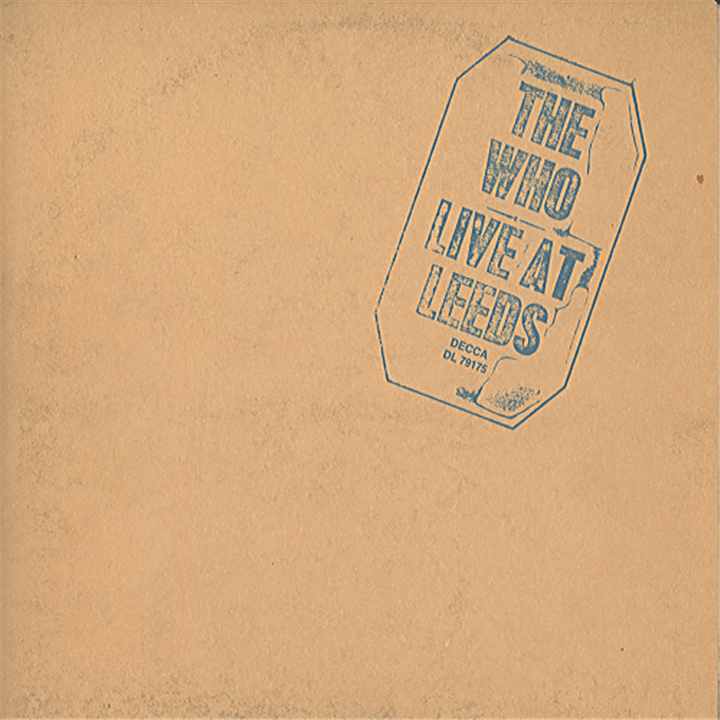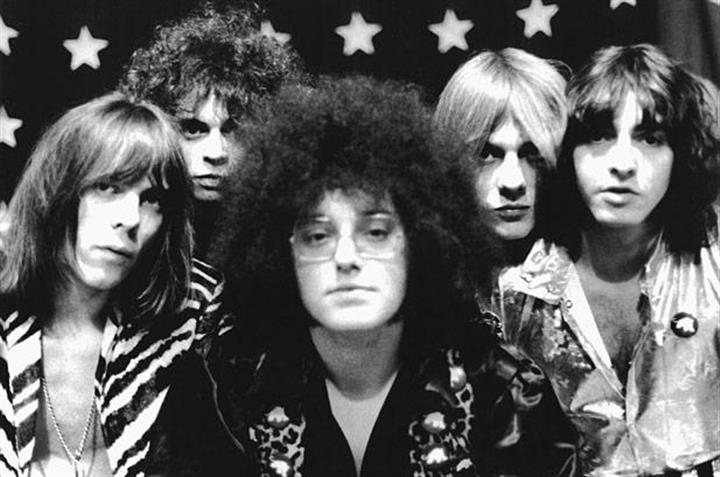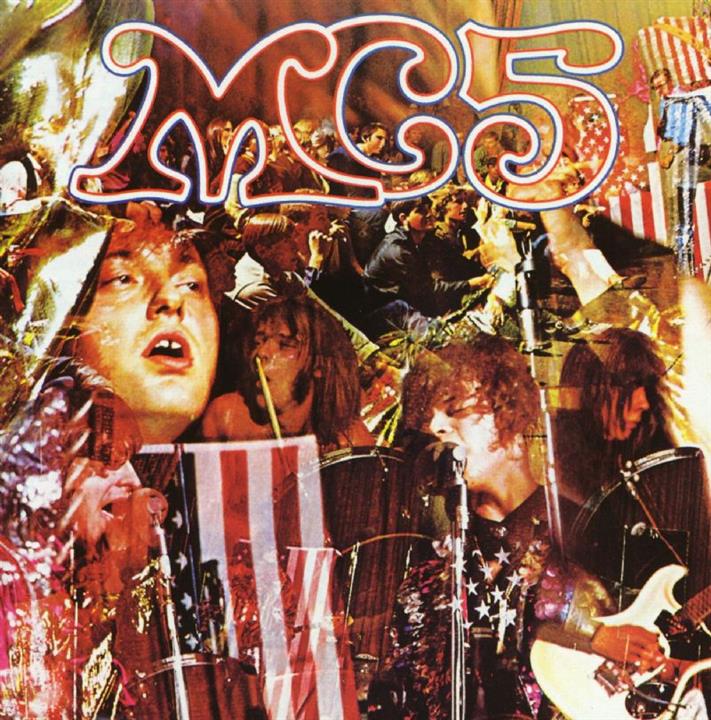The Who
As 2015 arrives, The Who have officially released 11 studio albums, 12 live albums, 26 compilations, and nearly 60 singles. On top of this, thousands—literally… thousands—of bootleg recordings of their live shows also exist. For anyone new to The Who’s music, the first question is an obvious one: where does someone interested in The Who’s music even begin?
In the late 1960s, seeing The Who live was like spotting a UFO: you knew that you’d just witnessed something not-of-this-earth, but it was tough to describe. And, after the event, the sonic experience became even harder to explain. The ‘life altering’ effects of witnessing a live Who show was something you’d remember ‘til the day you died. And something you’d (one day) try to tell your grandchildren about.
Recorded at Leeds University on Feb 14th, 1970, the original 6 song vinyl release of The Who’s Live at Leeds [MCA BD-31196] is a cornerstone in the history of harder rock albums. A double-disc version of the entire show was also released in 1995 [MCA MD-11215]. So fans wishing to hear the concert in its entirety can readily do so.
As good as the songs on their studio albums truly are, in the late 1960s, the volcanic energy which The Who unleashed live on stage was never quite captured within the studio environment.
On the same day that Live at Leeds was recorded, The Who were interviewed by Chris Smith of the Union News; the Leeds University student newspaper.
Guitarist Pete Townsend was quoted as saying: “Our act depends a lot on athleticism; it demands high volume. Even if the group ever gets quieter, we will always want voices loud- sounding huge and exciting. I don’t know how long it can go on. Now we are all so exhausted physically and mentally that we don’t feel the need for destruction anymore.”
And drummer Keith Moon commented: “We don’t make particularly good records. We have good ideas[,] but not always a good sound. We are difficult to record because we don’t work any different in the studio compared to on stage. Drumsticks are in the air when they should be on the drums[,] and arms are flying when they should be on guitar. In the studio, you should be session musicians[;] but we are not experienced enough at getting the dynamic sound on record without leaping about. We record clumsily and as loud as possible, so you just hear a long, drawn out row; which is old fashioned. It’s much the same on stage.”
The common themes in both of these comments are of chaos, power, and honesty. In the late 1960s, The Who were as genuine as could be. At that time, they were still young enough, and energetic enough, to play with a ferocious intensity. When Live at Leeds was recorded over 45 years ago in early 1970, there was absolutely nothing fake, phoney, or pretentious about The Who or their music. They were the real deal.
The Who played at ear-splitting volume levels, with a manic equipment destroying fervour, a resolute honesty, and a swirling on-stage chaos that only one or two bands throughout the entire history of hard rock ever managed to achieve; let alone record on tape.
And yet, The Who were more than just angry young lads standing at the centre of a prison-riot’s release of menacing, on-stage chaos. Through years of touring, they’d collectively developed a musical synergy which, on a good night, could take their songs and their audiences to a place of spiritual ecstasy.
The four members had a deft sense of being able to play off of one another. They could wander away from the core of a song and go exploring ‘off-piste’ into deeper and rougher out-of-bounds musical terrain with ease. And, unlike most bands, The Who’s members had the musicianship to bring the entire musical flying circus right back on track.
Roger Daltry’s vocals are confident and resolute in his conviction to not just sing the lyrics, but enunciate them with pride; and power. I’ve yet to see or hear a live Who show where Keith Moon ever played behind the beat. On Live at Leeds, Moon hammers away with an exhausting force and intensity. Bassist John Entwistle keeps the rhythm section tight, but also adds imaginative runs and powerful chords to cement the lower octaves with a solid foundation. And Pete Townsend plays his manic guitar solos and rock-of-Gibraltar chords like a man possessed.
The magical musical synergy which these four virtuoso musicians had together sends shivers up a listener’s spine. The breath-taking ‘Bedlam on a pogo-stick’ near chaos that usually occurred during The Who’s live shows is captured with excellent sonics on Live at Leeds. Combined with their sublime musical performances, this album is a superb place to start for anyone interested in exploring the musical heritage of The Who.
The MC5
Espousing a radical, counter-cultural, anti-everything political agenda, The Motor City Five (MC5 for short) were an American band formed in Lincoln Park, Michigan in 1964. Intent on unleashing a sonic tsunami of social upheaval, political revolution, and a concurrent wave of musical destruction, the MC5 represented the anti-establishment movement at its most volatile; and threatening.
On a good night, the MC5 could trump the ferocious on-stage energy and musical synergy of The Who. While they didn’t have the technical skills of Jimi Hendrix and the musicians he played with, the MC5 had attitude; in spades.
The MC5’s music contains elements of garage rock, hard rock, blues rock, and psychedelic rock which many have credited as being the foundation for the entire punk movement of the 1970s.
Packed to the brim with volatile explosives and deliberately set on fire for the ugly fun of seeing what might happen, live in concert, the MC5 played with the unstoppable force of a runaway freight-train, fast rolling at 90 MpH towards a catastrophic derailment. How the individual members of this band managed to keep in time with one another while unleashing so much anger, energy, and adrenalin is beyond me.
To their credit, on the live album Kick Out the Jams [Elektra CD 60894], the MC5 kept the train rolling right along and delivered one of the most staggering live rock’n’roll albums ever released.
Much in the same way that The Who readily acknowledged that, in the 1960s, their studio albums lacked the energy and synergy of their live shows, this is the MC5’s best album.
Recorded on October 30th and October 31st, 1968 at Russ Gibb’s Grande Ballroom in Detroit, Michigan, Kick Out the Jams showcases the musical genius of vocalist Rob Tyner, lead guitarist Wayne Kramer, rhythm guitarist Fred ‘Sonic’ Smith, bassist Michael Davis, and drummer Dennis Thompson.
Kick Out the Jams delivers an adrenalin-laced, ultra high energy set of 8 songs played with a fierce, tongue-in-cheek, rebellious attitude. The first 5 tracks on the album hit with all the subtlety of an air-to-ground missile slamming into the side of an unsuspecting passenger jet. The songs Ramblin’ Rose, Kick Out the Jams, Come Together, Rocket Reducer No. 62, and Borderline are well worth the sticker price for this album alone.
The last 3 songs are slower and have a blues inspired feel to them. The tracks Motor City is Burning, I Want You Right Now, and Starship all display the MC5’s willingness to experiment with a shotgun mixture of odd time signatures, 12-bar blues riffs, and psychedelic drugs like LSD and marijuana.
If you’re looking for some relaxing music to soothe your jangled nerves, look elsewhere. Re-released in 1991 with all of the MC5’s brash, vainglorious, and unrepentant rage intact, Kick Out the Jams is not an album for delicate ears. Be forewarned… the expletive-laced banter between songs is rude, crude, and as real as real can be; and is readily available on both CD and heavy-weight vinyl formats.
Bottom line, if this album doesn’t raise your blood-pressure, spike your heart rate, and have you turning the volume up WAY too loud with a twisted smile on your face, call a coroner, ‘cause you may already be dead. This is an album that simply refuses to be played quietly.
In Part #2 of this Feature Article on ‘The Origins of Harder Rock’, I’ll suggest albums for CANADA HiFi’s readers which were released in the late 1960s and early 1970s by Deep Purple, Black Sabbath, Led Zeppelin, and Cream.
Part 2 is now online and ready to read! Check it out here!








